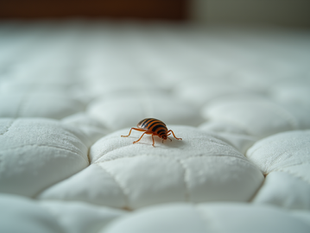
How to Identify Signs of a Bed Bug Infestation in Your Home
0
4
0
Bed bugs are tiny pests that can cause big problems in your home. They hide in cracks and crevices, feed on human blood, and multiply quickly. Detecting an infestation early is crucial to prevent a full-blown problem. This guide will help you recognize the signs of bed bugs and understand how to perform a thorough bed bug inspection.
Understanding the Importance of a Bed Bug Inspection
A bed bug inspection is the first step in controlling and eliminating these pests. Bed bugs are nocturnal and elusive, making them hard to spot. Without a proper inspection, you might miss the early signs and allow the infestation to grow.
Why Inspect?
Early detection helps reduce the spread.
Identifies the exact locations of bed bugs.
Helps determine the severity of the infestation.
Guides effective treatment plans.
What to Expect During an Inspection
A typical inspection involves checking common hiding spots such as mattresses, bed frames, furniture, and baseboards. Professionals use tools like flashlights, magnifying glasses, and sometimes specially trained dogs to detect bed bugs.

How to Perform a Bed Bug Inspection at Home
You can start by doing a simple inspection yourself before calling in professionals. Here’s a step-by-step guide:
Step 1: Gather Your Tools
Flashlight
Magnifying glass
Gloves
Plastic bags for collecting samples
Step 2: Inspect the Bed Area
Check mattress seams, tags, and piping.
Look under the mattress and box spring.
Examine the bed frame, especially joints and crevices.
Inspect bedding for small blood stains or dark spots.
Step 3: Check Furniture and Surroundings
Look inside drawers and behind headboards.
Inspect couches, chairs, and other upholstered furniture.
Examine baseboards, electrical outlets, and picture frames.
Step 4: Look for Physical Signs
Live bed bugs (small, reddish-brown, about the size of an apple seed).
Shed skins or exoskeletons.
Tiny white eggs or eggshells.
Dark fecal spots on fabric or wood.
Step 5: Use Traps and Monitors
Place bed bug interceptors under bed legs or use sticky traps to catch bed bugs moving around.
If you suspect an infestation but want a professional opinion, consider contacting a bed bug inspection service for a thorough evaluation.

Is Terminix Bed Bug Inspection Really Free?
Many pest control companies, including Terminix, offer free bed bug inspections as part of their service. This can be a great way to get a professional assessment without upfront costs. However, it’s important to understand what "free" means in this context.
What Does a Free Inspection Include?
Visual examination of your home by a trained technician.
Identification of bed bug presence or absence.
Recommendations for treatment if bed bugs are found.
Potential Costs After Inspection
Treatment plans are usually not free.
Follow-up visits may incur charges.
Some companies require a service agreement.
Tips for Using Free Inspections Wisely
Confirm what the inspection covers before scheduling.
Ask about any hidden fees.
Compare multiple companies to find the best service.
Free inspections can be a helpful first step, but always read the fine print and understand the full scope of services.
Common Signs of Bed Bug Infestation to Watch For
Recognizing the signs early can save you time and money. Here are the most common indicators:
1. Bites on Your Skin
Small, red, itchy bumps often in a line or cluster.
Usually appear on exposed skin like arms, neck, and face.
Can be mistaken for mosquito or flea bites.
2. Blood Stains on Sheets
Tiny rust-colored spots from crushed bed bugs.
Often found near the edges of mattresses or pillowcases.
3. Musty Odor
A sweet, musty smell caused by bed bug scent glands.
Noticeable in heavy infestations.
4. Bed Bug Exoskeletons
Shed skins left behind as bed bugs grow.
Found near hiding spots like mattress seams and furniture joints.
5. Live Bed Bugs
Small, flat, oval-shaped insects.
Active mostly at night, hiding during the day.
6. Dark Fecal Spots
Small black or brown spots on bedding, walls, or furniture.
These are digested blood excretions.

When to Call a Professional Bed Bug Inspection Service
If you notice any signs of bed bugs or suspect an infestation, it’s best to act quickly. DIY methods can help with early detection but may not be enough for complete removal.
Reasons to Hire Professionals
Expertise in identifying bed bugs accurately.
Use of specialized equipment and techniques.
Access to effective treatment options.
Peace of mind with thorough inspections.
What to Expect from a Professional Service
Detailed inspection of your entire home.
Customized treatment plan.
Follow-up visits to ensure eradication.
Advice on preventing future infestations.
Remember, a professional bed bug inspection service can save you time, reduce stress, and increase the chances of successful bed bug removal.
Protecting Your Home After a Bed Bug Inspection
Once you have identified or treated bed bugs, prevention is key to avoid reinfestation.
Tips for Prevention
Regularly inspect beds and furniture.
Use protective mattress and box spring covers.
Reduce clutter to eliminate hiding spots.
Vacuum frequently and dispose of vacuum bags immediately.
Be cautious when bringing used furniture or clothing into your home.
Seal cracks and crevices in walls and baseboards.
Monitoring
Continue using bed bug interceptors under bed legs.
Schedule periodic professional inspections if you live in a high-risk area.
Taking these steps will help keep your home bed bug-free and comfortable.
Identifying bed bugs early through a careful bed bug inspection is essential to protect your home and health. By knowing what to look for and when to call in professionals, you can tackle infestations effectively and prevent future problems. Stay vigilant and proactive to keep your living space safe from these unwelcome pests.






